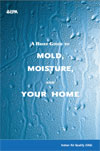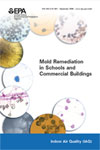Publications about Mold
On This Page:
- EPA Resources about Mold
- Other Resources about Mold
- Other Resources about Indoor Air Quality
- Damp Buildings and Health
EPA Resources about Mold


Other Resources about Mold
In January 2019, the National Institute for Occupational Safety and Health (NIOSH) released:
- Dampness and Mold Assessment Tool for Schools
- Dampness and Mold Assessment Tool for General Buildings
These tools may help identify and determine the severity of known and unknown areas of dampness and mold, prioritize repair and remediation, and track past and present problems.
Other Resources about Indoor Air Quality
- The National Institute for Occupational Safety and Health (NIOSH) has published: Preventing Occupational Respiratory Disease from Exposures Caused by Dampness in Office Buildings, Schools, and Other Nonindustrial Buildings. The guidance includes a building inspection checklist and may be of interest to people working in office buildings, schools and other nonindustrial buildings. Find the guidance at Preventing Occupational Respiratory Disease from Exposures Caused by Dampness in Office Buildings, Schools, and Other Nonindustrial Buildings. Exit
- World Health Organization (WHO) Document: WHO Guidelines for Indoor Air Quality: Dampness and Mould (PDF), World Health Organization, 2009 (248 pp, 2.65 MB) Exit
- Indoor Air Quality (IAQ) Publications
- Moisture Control
- Asthma Publications
- Radon Publications
- IAQ in Schools Publications
- Indoor airPLUS Publications
Damp Buildings and Health
For more information on damp buildings and health effects, see the 2004 Institute of Medicine Report, Damp Indoor Spaces and Health,Exit published by The National Academies Press in Washington, DC. You can read a description of the report and purchase a copy.
The Center for Disease Control and Prevention (CDC)
National Center for Environmental Health (NCEH)
(800) CDC-INFO (232-4636)
cdcinfo@cdc.gov
